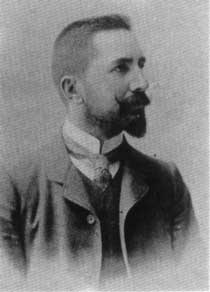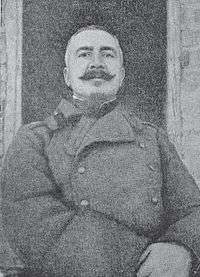Hristo Tatarchev
Hristo Tatarchev (Macedonian and Bulgarian: Христо Татарчев; December 16, 1869 – January 5, 1952) was a Bulgarian doctor and revolutionary,[1][2][3][4] the first leader of the revolutionary movement in Macedonia and Adrianople Thrace. He wrote a memoirs called The First Central Committee of the IMRO (1928). Tatarchev authored several political journalism works between the First and Second World War. According to post-WWII Macedonian historiography, he was an ethnic Macedonian.[5][6][7]
Hristo Tatarchev | |
|---|---|
 revolutionary | |
| Born | December 16, 1869 Resen, Ottoman Empire (today Republic of North Macedonia) |
| Died | January 5, 1952 (aged 82) |
| Nationality | Ottoman/Bulgarian/Italian |

Tatarchev was born in the town of Resen in Ottoman Macedonia to a rich family. His father Nikola Tatarchev was a successful banker, and his mother Katerina was a descendant of a prominent family. Hristo Tatarchev received his initial education in Resen, then he moved to Eastern Rumelia and studied in Bratsigovo (1882) and eventually at the Secondary school for boys in Plovdiv (1883–87). It was at that time when he participated in the Unification of Bulgaria and enrolled in a students' legion, which took part in the Serbo-Bulgarian War of 1885. Tatarchev was expelled from school because of "insubordination" and he moved to Romania, where he continued his secondary education. Later he studied medicine at the University of Zurich (1887–1890) and completed his degree in Medicine in Berlin (July 1892). He moved to Thessaloniki in 1892, where he worked as physician at the local Bulgarian secondary school for boys.[8]
He was a founding member of the Bulgarian Macedonian-Adrianople Revolutionary Committee (renamed to IMARO in 1906), which was established on October 23, 1893 in Thessaloniki. In the following year he was elected President of the Central Committee of IMARO. Tatarchev participated in the Thessaloniki Congress of BMARC in 1896.
In early 1901 he was caught by the Ottoman authorities and sent into exile for 5 years in Bodrum Castle in Asia Minor.[8] Although he was granted amnesty on August 19, 1902, Tatarchev did not give up revolutionary fight and in August 1902 he became a representative of the Foreign Committee of the IMRO in Sofia.[8] Being such, he met with the Minister of Foreign Affairs of Russia, Vladimir Lamsdorf (1845–1907), who had arrived in Bulgaria at the end of 1902. Tatarchev presented Lamsdorf with an IMARO-designed plan of reforms to be introduced in Macedonia. Tatarchev and Vladimir Lamsdorf organised a meeting to review the revolutionary ideas which could result in a successful revolt. During the Ilinden–Preobrazhenie Uprising of 1903, Tatarchev guided the revolutionary fight, as the emigrant representation turned out to be the sole governing body of the organization. To his credit, Tatarchev did not desert the revolutionary campaign when the uprising was quelled. Later he came in conflict with the supporters of Yane Sandanski and did not participate in the activities of the IMRO to the Kyustendil Congress in March 1908, where he was appointed as an adviser to the Foreign Committee of the IMRO. After the Young Turk Revolution he openly supported the Union of the Bulgarian Constitutional Clubs, but did not participate in its activities. In 1910 he was elected a reserve member of the Central Committee of IMRO. When Bulgaria entered the Balkan Wars and the First World War, Tatarchev was sent to the front as a regimental physician. At the end of the wars he was one of the initiators of the Temporary representation of the former IMARO.
In the fall of 1920 he entered the Macedonian Federative Organization. Shortly after that Tatarchev was forced to emigrate in Italy, because of significant discord between then IMRO's leader Todor Alexandrov and him. He lived briefly in his native Resen during the Second World War, when Macedonia was annexed of Bulgaria (1941–1944). Later he returned to Sofia, but in 1943 after the bombings there Tatarchev moved to Nova Zagora. He was offered in 1944 from the Germans to become a President of the Independent State of Macedonia, but he refused, because the Red Army was entering Bulgaria. Bulgaria also ordered its troops to prepare for withdrawal from former Yugoslavia.[9] Because of the communist regime imposed in Bulgaria and Yugoslavia Tatarchev moved to Turin again, where he died on January 5, 1952.[8]
In December 2009, his mortal remains were brought from Turin to Bulgaria by VMRO-BND, a contemporary national political party claiming descent from the IMRO. Tatarchev's reburial took place in Sofia, on October 23, 2010, exactly 117 years since the founding of the IMRO.
Honours
_3.jpg)
Tatarchev Nunatak on Oscar II Coast in Graham Land, Antarctica is named after Hristo Tatarchev.
References
- In Salonica, in November 1893, four teachers, a bookseller, and a physician founded the most famous Macedonian organization. Its exact name is disputed. Initially it was called Macedonian Revolutionary Organization (MRO), but in 1896 it assumed the title Bulgarian Macedo-Adrianopolitan Revolutionary Committees (BMORK) and membership was open to ‘any Bulgarian’ who desired to serve the ‘cause’, namely liberation from the Turkish yoke and the political autonomy of Macedonia. The much-praised autonomist solution must not be taken atface value; autonomy meant preservation of the territorial integrity of Macedonia which could eventually lead to incorporation of the region into Bulgaria. A convenient precedent had been already established by the annexation of Eastern Rumelia to Bulgaria in 1885. Besides, any proposal for direct annexation of Macedonia would have met with the refusal of the Great Powers. According to Christo Tatarchev this was the reason which forced them to put forward the idea of ‘autonomy’ instead of ‘annexation’. Dimitris Livanios, The Macedonian Question: Britain and the Southern Balkans 1939-1949, Oxford Historical Monographs, OUP Oxford, 2008, ISBN 0191528722, p. 17.
- The modern Macedonian historiographic equation of IMRO demands for autonomy with a separate and distinct national identity does not necessarily jibe with the historical record. A rather obvious problem is the very title of the organization, which included Thrace in addition to Macedonia. Thrace whose population was never claimed by modern Macedonian nationalism... There is, moreover, the not less complicated issue of what autonomy meant to the people who espoused it in their writings. According to Hristo Tatarchev, their demand for autonomy was motivated not by an attachment to Macedonian national identity but out of concern that an explicit agenda of unification with Bulgaria would provoke other small Balkan nations and the Great Powers to action. Macedonian autonomy, in other words, can be seen as a tactical diversion, or as “Plan B” of Bulgarian unification. İpek Yosmaoğlu, Blood Ties: Religion, Violence and the Politics of Nationhood in Ottoman Macedonia, 1878–1908, Cornell University Press, 2013, ISBN 0801469791, pp. 15-16.
- Autonomy for Macedonia and the vilayet of Adrianople (southern Thrace) became the key demand for a generation of Slavic activists. In October 1893, a group of them founded the Bulgarian Macedono-Adrianopolitan Revolutionary Committee in Salonica...It engaged in creating a network of secretive committees and armed guerrillas in the two regions as well as in Bulgaria, where an ever-growing and politically influential Macedonian and Thracian diaspora resided. Heavily influenced by the ideas of early socialism and anarchism, the IMARO activists saw the future autonomous Macedonia as a multinational polity, and did not pursue the self-determination of Macedonian Slavs as a separate ethnicity. Therefore, Macedonian (and also Adrianopolitan) was an umbrella term covering Bulgarians, Turks, Greeks, Vlachs, Albanians, Serbs, Jews, and so on. While this message was taken aboard by many Vlachs as well as some Patriarchist Slavs, it failed to impress other groups for whom the IMARO remained ‘‘the Bulgarian Committee.’’ Historical Dictionary of Republic of Macedonia, Historical Dictionaries of Europe, Dimitar Bechev, Scarecrow Press, 2009, ISBN 0810862956, Introduction.
- Татарчев, Христо. Спомени, документи, материали, София 1989, с. 68, 75 (Tatarchev, Hristo. Memoirs, documents, materials, Sofia 1989, p. 68, 75)
- The origins of the official Macedonian national narrative are to be sought in the establishment in 1944 of the Yugoslav Republic of Macedonia. This open acknowledgment of the Macedonian national identity led to the creation of a revisionist historiography whose goal has been to affirm the existence of the Macedonian nation through the history. Macedonian historiography is revising a considerable part of ancient, medieval, and modern histories of the Balkans. Its goal is to claim for the Macedonian peoples a considerable part of what the Greeks consider Greek history and the Bulgarians Bulgarian history. The claim is that most of the Slavic population of Macedonia in the 19th and first half of the 20th century was ethnic Macedonian. For more see: Victor Roudometof, Collective Memory, National Identity, and Ethnic Conflict: Greece, Bulgaria, and the Macedonian Question, Greenwood Publishing Group, 2002, ISBN 0275976483, p. 58; Victor Roudometof, Nationalism and Identity Politics in the Balkans: Greece and the Macedonian Question in Journal of Modern Greek Studies 14.2 (1996) 253-301.
- Yugoslav Communists recognized the existence of a Macedonian nationality during WWII to quiet fears of the Macedonian population that a communist Yugoslavia would continue to follow the former Yugoslav policy of forced Serbianization. Hence, for them to recognize the inhabitants of Macedonia as Bulgarians would be tantamount to admitting that they should be part of the Bulgarian state. For that the Yugoslav Communists were most anxious to mold Macedonian history to fit their conception of Macedonian consciousness. The treatment of Macedonian history in Communist Yugoslavia had the same primary goal as the creation of the Macedonian language: to de-Bulgarize the Macedonian Slavs and to create a separate national consciousness that would inspire identification with Yugoslavia. For more see: Stephen E. Palmer, Robert R. King, Yugoslav communism and the Macedonian question, Archon Books, 1971, ISBN 0208008217, Chapter 9: The encouragement of Macedonian culture.
- "However, contrary to the impression of researchers who believe that the Internal organization espoused a "Macedonian national consciousness," the local revolutionaries declared their conviction that the "majority" of the Christian population of Macedonia is "Bulgarian." They clearly rejected possible allegations of what they call "national separatism" vis-a-vis the Bulgarians, and even consider it "immoral." Though they declared an equal attitude towards all the "Macedonian populations." Tschavdar Marinov, We the Macedonians, The Paths of Macedonian Supra-Nationalism (1878–1912), in "We, the People: Politics of National Peculiarity in Southeastern Europe" with Mishkova Diana as ed., Central European University Press, 2009, ISBN 9639776289, pp. 107-137.
- Shea, John (1997). Macedonia and Greece: The Struggle to Define a New Balkan Nation. McFarland & Company. p. 171. ISBN 0-7864-0228-8.
- Македонската кървава Коледа. Създаване и утвърждаване на Вардарска Македония като Република в Югославска Федерация (1943-1946) Автор: Веселин Ангелов, Издател: ИК "Галик ", ISBN 954-8008-77-7, стр. 113 - 115.
External links
- A collection of Hristo Tatarchev's interwar publications (in Bulgarian)
- Hristo Tatarchev's memoirs (in Macedonian)